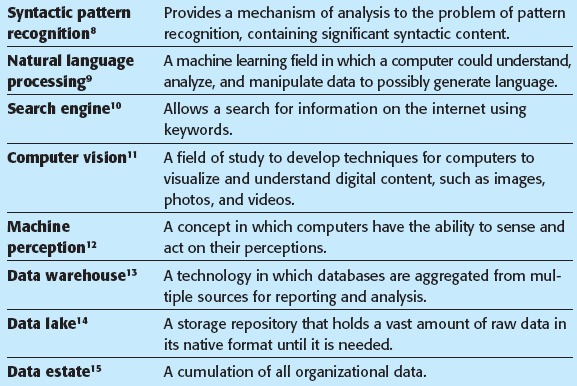Abstract:
Artificial intelligence (AI) is a transformational technology that will affect all healthcare providers. This article offers an overview of basic AI concepts and the role of nurses in embracing this technology in healthcare settings.
Keywords: AI, algorithm, artificial intelligence, behavioral analytics, clinical analytics, machine learning, operational analytics
This overview of artificial intelligence (AI) in healthcare settings examines basic AI concepts and the role of nurses using this cutting-edge technology.
Figure.

No caption available.
ARTIFICIAL INTELLIGENCE (AI) is evolving and will transform healthcare. Given the potential of this technology for patient care and its impact on clinical providers, it is essential for nurses to have a basic understanding of AI concepts. This article examines the technology and the role of nurses in incorporating it into the healthcare setting.
Significant savings
AI is a popular topic of discussion, and it is hard to find a conference, committee, article, or report that does not mention it. This is not surprising, as the potential healthcare savings of this technology could reach $150 billion by 2025.1 Approximately half of this figure represents clinical savings, while the other half represents financial and operational costs.1
AI fundamentals
AI is defined as the theory and development of computer systems able to complete tasks that typically require human intelligence, such as visual perception, speech recognition, decision-making, and/or language translation.2 Simply put, it is the ability of a machine to emulate intelligent human behavior and represents an umbrella term for machine learning (ML), computer vision, and natural language processing (NLP) technologies (see Coming to terms with AI). Each of these can be used individually or in combination to add intelligence to applications.
ML is a subset of AI defined as enabling computing advances through testing and adaptation scenarios and by using trends and patterns for improved decision-making.3 Syntactic pattern recognition, NLP, search engines, computer vision, and machine perception are other examples of ML applications.3
The accuracy of prediction or recognition is contingent on two factors: the training and the algorithm.4 ML models are created by feeding data into an algorithm. This algorithm is a process or set of rules to be followed by a computer in calculating or problem-solving. The magic happens in the algorithm.4
Table.
Coming to terms with AI

Training is done using reliable data. Over time, retraining can occur using newly created data.4 For example, to predict patient lengths of stay based on their diagnosis, an algorithm would be written and trained on accurate and reliable data. These include electronic health records, medical claims, facility supply chain, and patient-generated data. Over time, the model is continuously retrained with recent data, increasing its efficacy and reliability.
AI and analytics
Nurses should understand how AI is utilized in patient care. Some transformational uses of the technology include accelerating innovation, improving decision-making, automating and speeding up processes, and saving overall costs. In healthcare, AI is seen as a potential solution for handling massive increases in complex medical data, but only 15% to 20% of end users are using it to drive changes in the delivery of patient care.1
There are three types of analytics:
Clinical analytics generate insights and improve treatment and outcomes. Among the many examples of AI for clinical analytics are clinical pathway prediction, disease progression prediction, health risk protection, predictive risk scoring, and virtual assistants embedded in clinical systems for workflow improvements. AI may also be used in disease management, assisting with the differential diagnosis on medical images and combining patient data with academic evidence and regulatory guidelines to personalize treatment plans.
Operational analytics improve the efficiency and effectiveness of systems that provide and manage care processes. The ability to predict operational issues and track safety metrics, maintain equipment, monitor the supply chain, and identify fraud are examples of AI in healthcare. Other operational improvements include documentation coding to process claims and new platform interfaces to adjust claims automatically for reimbursement in revenue cycle management.
Behavioral analytics examine consumer behavior patterns that inform healthcare delivery. The technology also increases the probability of actions taken to improve the adoption of recommended practices. It leverages AI for patient engagement, well-being, and readmissions and health.
Challenges and limitations
AI is already present in healthcare. It can be utilized in clinical decision support, disease management, patient engagement, and operational improvements. By 2020, most organizations will use it, as this technology continues to be made readily available for everyone.5 That said, healthcare organizations may be faced with several challenges as they begin to deploy AI.
As much of healthcare data are siloed and unstructured, one challenge is a lack of mature data estates to serve as a foundation for AI strategies.3 Data estates are essential in collecting and storing information in its native format. Modern data estates include operational databases, data warehouses, and data lakes. The paradigm shift to AI will require a significant skills transformation among healthcare staff. AI technology is still emerging, is in a state of continuous change, and has not yet matured.
Despite concerns among healthcare organizations and information technology vendors alike, the need for interoperability between programs is becoming more recognized as an important area of development to leverage AI platforms. The US Department of Health and Human Services, the Centers for Medicare and Medicaid Services, and the Office of the National Coordinator for Health Information Technology recently proposed rules to promote interoperability in healthcare in the US.6 Similarly, the Trusted Exchange Framework and Common Agreement has been updated in an effort to foster a nationwide exchange of electronic health information across the different networks.7
Leading healthcare organizations will need to adjust to a rapid rate of technologic innovation. Facilities must enable their technical development teams with AI, allowing them to incorporate it into applications within their purview and expand it to redefine business and clinical processes. Next, AI must be brought to every employee by incorporating it into their workflow through processes and procedures to amplify all functions within the organization. Nurses should be at the forefront of this transformational technology and empowered throughout the implementation process.
Transforming healthcare
The determination to achieve better patient outcomes at lower costs is a catalyst for disruptive technology, or one that will displace existing technologies. Powerful computing capabilities; large amounts of data; and the development of techniques such as clinical, operational, and behavioral analytics can be combined and leveraged for personalized and population-based care. As AI evolves, it will fundamentally transform healthcare organizations and care delivery.
The issues surrounding AI are novel and complex, and there is still much to be learned. Healthcare organizations will need to harness the power of AI to provide the most value for providers and patients. Equipped with the knowledge of how it can contribute to patient care and outcomes, nurses should be the vanguard and embrace the use of AI in healthcare settings.
REFERENCES
- 1.Frost and Sullivan. Artificial intelligence in healthcare takes precision medicine to the next level. Cision: PR Newswire. 2018. www.prnewswire.com/news-releases/artificial-intelligence-in-healthcare-takes-precision-medicine-to-the-next-level-300712098.html.
- 2.Pan Y. Heading toward Artificial Intelligence 2.0. Engineering. 2016;2(4):409–413. [Google Scholar]
- 3.Obermeyer Z, Emanuel EJ. Predicting the future–big data, machine learning, and clinical medicine. N Engl J Med. 2016;375(13):1216–1219. [DOI] [PMC free article] [PubMed] [Google Scholar]
- 4.Starr D. Current use cases for machine learning in healthcare. Microsoft Azure. 2018. https://azure.microsoft.com/en-us/blog/current-use-cases-for-machine-learning-in-healthcare. [Google Scholar]
- 5.Panetta K. 5 trends emerge in the Gartner Hype Cycle for emerging technologies, 2018. Gartner. 2018. www.gartner.com/smarterwithgartner/5-trends-emerge-in-gartner-hype-cycle-for-emerging-technologies-2018. [Google Scholar]
- 6.US Department of Health and Human Services. HHS proposes new rules to improve the interoperability of electronic health information. 2019. www.hhs.gov/about/news/2019/02/11/hhs-proposes-new-rules-improve-interoperability-electronic-health-information.html.
- 7.The Office of the National Coordinator for Health Information Technology. Trusted Exchange Framework and Common Agreement. HealthIT.gov. 2019. www.healthit.gov/topic/interoperability/trusted-exchange-framework-and-common-agreement
- 8.Fu K, Swain PH. On syntactic pattern recognition. SEN Report Series Software Engineering. 1971;(2):155–182. [Google Scholar]
- 9.Shetty B. Natural language processing (NLP) for machine learning. Towards Data Science. 2018. https://towardsdatascience.com/natural-language-processing-nlp-for-machine-learning-d44498845d5b. [Google Scholar]
- 10.College of Southern Nevada: College Library Services. Databases vs. search engines: what's the difference? www.csn.edu/sites/default/files/legacy/PDFFiles/Library/dbasesearch3.pdf.
- 11.Brownlee J. A gentle introduction to computer vision. Machine Learning Mastery. 2019. https://machinelearningmastery.com/what-is-computer-vision. [Google Scholar]
- 12.Lustig T. Fueling science and research through machine perception. Mellanox Technologies. 2017. www.mellanox.com/blog/2017/09/science-research-machine-perception-ai. [Google Scholar]
- 13.Informatica. What is data warehousing? 2019. www.informatica.com/services-and-training/glossary-of-terms/data-warehousing-definition.html#fbid=76YEJbFxLn5.
- 14.Chinnakali K. 9 key benefits of data lake. Data Science Central. 2016. www.datasciencecentral.com/profiles/blogs/9-key-benefits-of-data-lake. [Google Scholar]
- 15.Kumar R. SQL server blog: Microsoft for the modern data estate. Microsoft. 2017. https://cloudblogs.microsoft.com/sqlserver/2017/09/25/microsoft-for-the-modern-data-estate. [Google Scholar]


